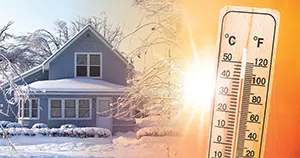Did you know as an HVACR leader, you can capitalize on weather-triggered marketing? It’s true. Of course, no one can control the weather, but in many ways, the weather controls us. From how we dress, what we eat, to where we go, and how we feel – the weather outside plays a role in our decisions and purchasing behavior as consumers – whether we are conscious of it or not. However, those who work in the HVACR industry, are quite conscious of the impact of weather. It has a clear and direct connection to your business. To deliver clear and measurable results, you need only dig into the data. Thus, leveraging the weather in your HVACR marketing strategy makes perfect sense.
Understanding How Weather Affects HVACR Sales
It might seem obvious that HVACR customers want to be warm in the winter and cool in the summer. But the weather’s influence works in much more granular ways as well. Do you understand how impactful the weather patterns are on your business?
Weather-triggered marketing uses weather data to create adaptive campaigns that consider the finer impact of different weather conditions.
Take, for example, a Canadian study that looked at sunlight, consumption, and spending. According to the study, when exposed to sunlight, consumers were willing to pay 37 percent more for green tea, as opposed to during cloudy conditions, when they were more likely to spend money on alcohol and coffee.
A more nuanced understanding of weather-triggered consumer behavior, can be of great benefit for those in the HVACR industry. By using past sales data analysis in conjunction with weather databases, contractors can get more from their traditional marketing strategies. Weather-triggered marketing reveals hidden patterns of customer behavior that isn’t obvious without the benefit of this more advanced analysis.
Intuition won’t reveal the following HVACR weather-triggered consumer patterns, including:
- How product sales align with specific temperatures and weather patterns. Weather-triggered marketing can be a valuable tool for planning and filling the job board. You can visualize your sales data in the context of weather to get a clearer read on sales cycles and then adjust your marketing to upsell equipment or maintenance sales accordingly. The temperature “sweet spot” tends to be roughly 68 degrees. The farther the temperature strays, the more discomfort there will be. At the extremes, smaller temperature changes can start having a more noticeable effect. Understanding these trends and the subsequent behaviors, will make your marketing and staffing more robust and multi-layered.
- The specific temperature changes that trigger certain behaviors. Typically, a 10–15-degree weather change will prompt customer behavior trends. An in-depth analysis can help define what that looks like for your customers. Remember, people who are conditioned to different climates will perceive weather differently. Seventy degrees will feel very warm to a northerner coming out of winter, but quite cool to someone acclimated to warmer temperatures.
- How to assess customers’ responses which will vary between significant and seasonal weather events. An analysis of your customer database can help with demographic segmentation to see if people with shared characteristics behave similarly. For example, people over age 60 living in older homes, tend to be more receptive to service contracts and seasonal maintenance. You’ll get a better advertising ROI if you more precisely target the right current and prospective customers with relevant services.
- How to maximize peak sales cycles and minimize sales troughs. Extreme temperatures can spike service calls by more than 100%. A weather-triggered marketing campaign can automatically monitor the extended forecast, looking for conditions likely to increase sales. You can extend these windows by launching digital ads several days ahead of time with a message, for example, that asks if their A/C unit is ready for the 95-degree weather, forecasted for Wednesday. Conversely, the weeks leading up to your traditionally slowest seasonal sales, are a good time to push service contracts and often-neglected preventative services.
Utilizing this weather-triggered analysis, allows you to better predict future sales opportunities and capitalize on them. Then, you can plan marketing efforts and infuse them with real-time data that makes the ads more relevant and attention-getting. One HVACR dealer identified which neighborhoods were prone to flooding during significant rainfalls. When major storms were forecast, the company had campaigns ready to launch with special offers for water-damaged systems.
B2E Data Marketing analyzed the incoming customer calls for a national HVACR company, key patterns quickly emerged. We were able to discern, for each local dealer, the magnitude of temperature swings that caused more people to call compared to a typical day, and what to expect. Once these patterns were identified, each local HVACR dealership planned appropriate staffing for the anticipated work. Prior to this, the dealerships had to turn away business when they did not have enough service technicians.
Six Smart Ways to Use Weather-Triggered Marketing
There are many ways that HVACR businesses can begin to incorporate weather data into marketing efforts. Ultimately, weather-triggered marketing is designed to connect your business with potential customers when there is prime purchase intent. Your budget will vary based on factors such as audience size and creative advertising, but many HVACR companies prefer to prepay for several campaigns that will launch automatically based on their identified weather triggers.
Here are six strategies to consider when launching weather-triggered marketing:
- Drive future sales based on weather patterns. Establish a clearer understanding of exactly which products and services perform best under certain types of weather events. Combine weather data with information such as demographics and age of home, to know which products to offer, to whom, and when.
- Create intelligent campaign triggers. As an example, you can automatically display digital ads in your service territory for the specific products or services that sell best under specified weather conditions. These ads can be shown during Google searches, on social media networks, and within the websites being visited by your current and potential customers.
- Personalize your advertising. In-corporate data about real-time current weather conditions along with a customer’s sales history, to create customized ads, promotions, and new service packages. One HVACR company analyzed its own customer data to develop a detailed profile of the ideal customer for service contracts, and when it was that they preferred to purchase. The owner then used the anticipated weather events to target prospective customers fitting this profile with tailored messaging.
- Capitalize on significant weather events. Run targeted campaigns in the days leading up to and following big weather events to drive additional revenue.
- Run seasonal and cyclical campaigns. Plan campaigns during the time periods that customers are more likely to request services – and also during traditionally slow times. A simple service reminder with a timely weather message can help quickly and efficiently fill appointments when technicians aren’t busy enough.
- Manage inventory and staff. When you have a more exact understanding of weather-related demand implications, you can ensure that you have appropriate levels of supplies, inventory, and staff to optimize operations.
Fickle Weather, More Targeted HVACR Marketing
The weather may be fickle, but your HVACR marketing efforts shouldn’t be. Incorporating weather data analysis can help contractors make every dollar work smarter. Weather-triggered marketing will “shed sunlight” on your sales trends, increase your profitability, and create more meaningful engagement with customers.
Keith Snow is the president of B2E Data Marketing. The data scientists at B2E built their own historical weather database that includes high and low temperatures, average wind speed, precipitation, snow fall and snow depth for every day, every U.S. zip code – going back 10 years. B2E’s WeatherFootprint tool contains 150 million records and 41,000 zip codes of data. It can match your historical sales data to the weather patterns unique to your location to determine the sales impact of different weather conditions. Learn more at b2edata.com.



